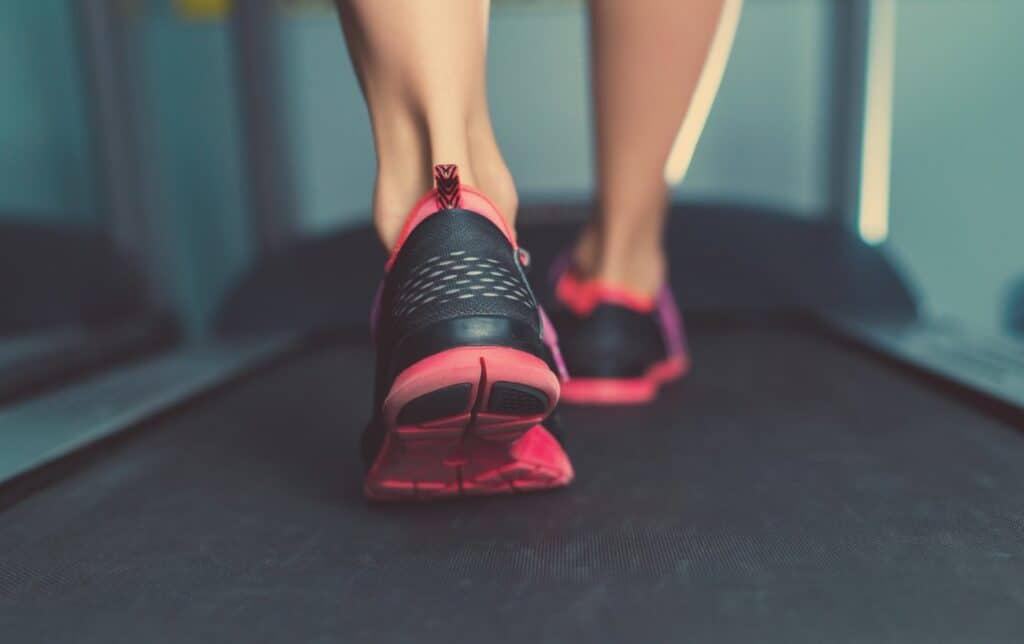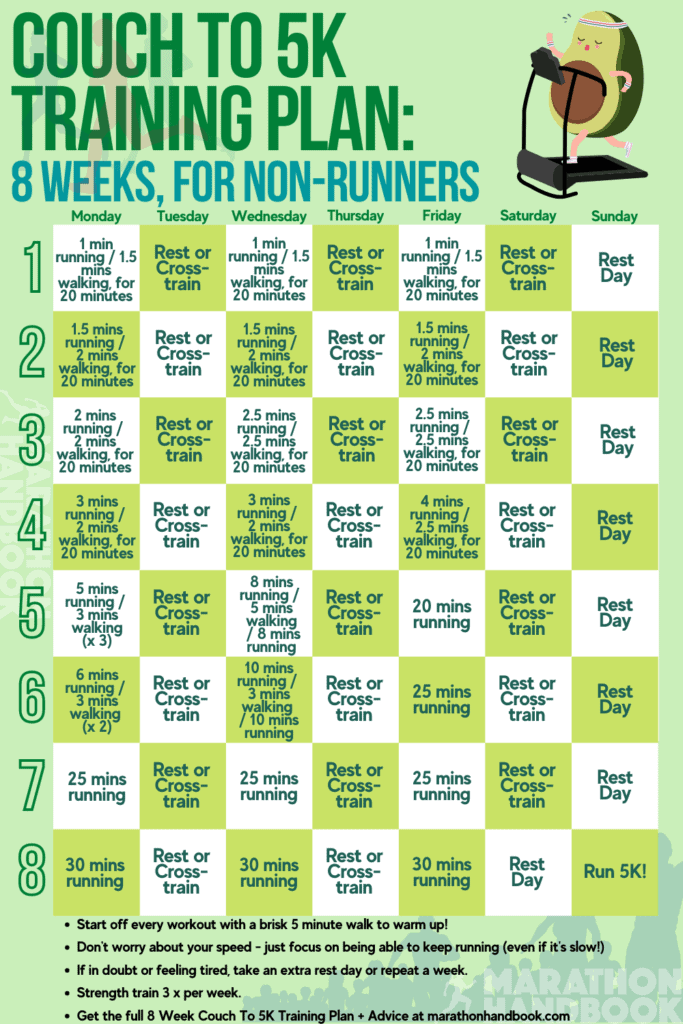The Couch To 5k running program is perfect for beginner runners who want to start running but need a running plan for complete beginners.
Taking on a Couch to 5k training plan takes you from the first day you lace up your running shoes through the build up to the finish line of your first 5k race.
But, if you have wanted to do the Couch to 5k plan but don’t have the availability to train outside, we have a solution for you!
You can tackle our Couch to 5k training plans from the comfort of your own home, on a treadmill!

Can I Really Train For a Couch to 5k on a Treadmill?
Yes, of course you can.
Our C25k treadmill plan may be even simpler and more convenient than having to organize yourself to train outdoors.
Let’s take a quick look at some of the benefits of treadmill training.
Related: How To Run On A Treadmill: Basics, Benefits + 5 Fun Workouts To Try
4 Benefits of Treadmill Training For Couch To 5k
#1: Convenience and Safety
If you have a tricky work or life schedule that doesn’t allow you to plan your runs in an ideal fashion, having access to a treadmill will help facilitate your training.
You can train any time, day or night, and sneak in your training sessions when they are convenient for you.
With treadmill workouts, you won’t have to worry about running during rush hour traffic and dodging cars, or going out after dusk which could be dangerous if the area is not well-lit.
There also may be times when you just can’t leave your home because your kids can’t be left alone, or you are expecting an important delivery.
Having the convenience of training whenever you want on your terms will allow you to stick to your commitment and achieve your goal.

#2: Rain, Rain Go Away!
Have you ever woken up, looked out the window, and thought to yourself, no way, I am NOT going out there?
The trees are doubled over and that wind will literally blow me away.
No matter what Mother Nature throws at you, whether it be snow, rain, or wind, doing your C25k walk/run workouts indoors on the treadmill will allow you to train safe and sound in your nice, cozy home.
Long winters make it tough to get in your runs outside, especially if your schedule calls for you to run early in the morning.
It’s just too dark and too cold to get out there and have a successful session. Being able to jump on the treadmill is a great solution.
Check out 8 more practical Couch To 5k Tips here!
#3: Accurate Pacing
Once you have learned how to work your treadmill, pacing becomes a piece of cake. You don’t even need a watch to track your time or speed because it will all be displayed for you on the screen.
You won’t speed up or slow down involuntarily because to change the speed on the treadmill you consciously have to press a button. This is great for maintaining consistent paces and will prevent you from pushing too hard, too fast.
Plus, if your training schedule says warm up with a 5 minute walk at a brisk pace and then start your walk/run intervals with 2 minutes of running and 1 minute of walking at an easy pace, you can see the timer right on the treadmill display as you go, so you don’t have to keep checking your watch.
This helps you just focus on getting a good cardio workout without constantly worrying about paces or interval times. Talk about convenience!

#4: In-House Entertainment
There are endless options to entertain yourself while training indoors.
Depending on how modern your treadmill is, it may come with virtual running routes that you can choose to explore.
Try running along the Charles River in Boston, or take a jog around Central Park in New York.
Following these virtual routes are entertaining and fun, and will make the time fly by.
Alternatively, you could listen to your pump-up playlist, audiobooks, or podcasts, or take advantage of your access to a television! Watch that series you never have time for, or a movie, or even a bake-off! By keeping your mind occupied, your workout will be over before you know it.
By now you must be motivated to get started on your Couch to 5k on a treadmill, so let’s take a look at some helpful hints for training indoors.
And check out these Top 7 Couch to 5k Mistakes to Avoid!
What Are the Best Training Tips for C25k Treadmill Plans?
#1: Get Familiar With Your Treadmill
It’s important you learn how your treadmill works before you get started, that way, you will avoid any mishaps during your sessions and can train effectively from your very first workout.
Check out the display and be sure you can see the chronometer, your speed and/or pace, and the incline. Identify which buttons control these variables as they might be on the console or on the handrails.
Practice using the controls before beginning and be sure you have it set up just the way you want it.

#2: Treadmill Incline
Since you will be training indoors, you will not experience the change in terrain that you would if you were running outside, which can set you up for surprises with the challenge of running hills on race day if your target 5k race has a hill (or two!).
As you progress in the Couch to 5k treadmill running program, you can increase and decrease the incline percentage on the treadmill to simulate running outside on an uneven surface.
We would suggest a 1% incline1Jones, A. M., & Doust, J. H. (1996). A 1% treadmill grade most accurately reflects the energetic cost of outdoor running. Journal of Sports Sciences, 14(4), 321–327. https://doi.org/10.1080/02640419608727717 to replicate outdoor running with bumping up to 3% for occasional “hills.”
#3: Treadmill Features
Take advantage of all the cool features your treadmill has. Read up on the specific model and its unique options. There are some programmable treadmills where you can actually set up your training beforehand, press start, and the interval changes will be automatic!
No worrying about watching the time, you can just run!
#4: Watch Your Step!
You want to avoid looking down at your feet while you are running on a treadmill. This could cause you to get disoriented and make you lose your balance.
If you need to stop and get off during your workout, be sure to decrease the speed and hold on to the handrails before carefully stepping off.
#5: Emergency Cord
If you don’t know what that little red dangly cord that is hanging off the front of your treadmill is for, it’s for your safety! Most treadmills have this emergency feature in case you lose your balance and fall.
Attach the clip of the cord comfortably to your shirt or shorts while training. The other side is a magnet that attaches to the machine. If something were to happen, the magnet would detach from the treadmill, and the band would stop running.

#6: Posture
Run on the treadmill as if you were running outside.
Keep an eye on your posture and be sure it is consistent with your outdoor running posture: stay upright, maintain a quick cadence without heel striking, and most importantly, do not hold on to the handrails.
Handrails are there as safety measures only.
If you hold on to them, they will make your workout much easier and you will not reap the same benefits nor put in the same amount of effort as if you were running normally.
Running should be a full body exercise; not just a leg workout!
It may take a while, but you’ll get the hang of running on a treadmill so you can do it confidently and eventually feel comfortable speeding up.
At What Speed Should I Run While Treadmill Training For My C25K?
Our couch to 5k program uses an interval training method where you will alternate between walking and running.
It’s a bit tricky to predict which speeds you will use, as you are just starting out. They will be affected by factors such as your current fitness level, age, and weight. However, we can give you an approximate range to help get you started.
Using the perceived effort scale and these suggested speeds, you will be able to quickly adjust them to what works for you.
For a complete beginner, your walking speed could range from 4-5 kph (kilometers per hour), and an average jog could be anywhere from 6-8 kph.
On your treadmill, you will see two different presentations of your speed: kilometers per hour, and/or minutes per kilometer. Here is a quick table to show you the difference.
| KM PER HOUR | MIN PER KM | MILES PER HOUR | MIN PER MILE |
| 4 | 15:00 | 2.48 | 24:11 |
| 5 | 12:00 | 3.10 | 19:21 |
| 6 | 10:00 | 3.72 | 16:07 |
| 7 | 8:34 | 4.34 | 13:49 |
| 8 | 7:30 | 4.97 | 12:04 |
The most important thing is that you do not start out too fast and burn out during your workouts. You want to be able to maintain a comfortable, conversational pace.
This means that you should be able to carry on a conversation with someone without gasping for breath.
The pace may seem slow to you at first, but remember, consistency is key.
As your pacing may be complicated to figure out at first, gauge it for yourself. If you feel your heart rate rising too much and you feel as though you are breathing too heavily, slow down and fall back into a more comfortable pace.
During the walk intervals, don’t slow down too much. Be sure you stay at a nice brisk walk so you keep your heart rate consistent.
Don’t Forget to Warm Up and Cool Down
Warm up
Warming up correctly before a running workout is essential to prepare your body for what’s to come and to prevent injuries.2Ding, L., Luo, J., Smith, D. M., Mackey, M., Fu, H., Davis, M., & Hu, Y. (2022). Effectiveness of Warm-Up Intervention Programs to Prevent Sports Injuries among Children and Adolescents: A Systematic Review and Meta-Analysis. International Journal of Environmental Research and Public Health, 19(10), 6336. https://doi.org/10.3390/ijerph19106336
You need to get yourself moving, gradually bring your heart rate up and get oxygen to your muscles.
It is important that your warm up is run-specific and dynamic and that you do not do any static stretching before running as it could make you more prone to injury. We leave static stretching for the end when we have completed our workout.
Here is an example of a runner’s warm up:
Walk briskly for 5-10 minutes on the treadmill at a comfortable pace that will gradually raise your heart rate.
After you are nice and warm, activate your muscles with dynamic stretching such as leg swings, scoops, and lunges.
Now you are ready for your interval session!
After your workout, don’t forget to cool down and stretch. Most find this the most tedious part of running, but it is incredibly important.

Cool down
Don’t stop suddenly after your workout, but instead, bring your heart rate back down little by little, begin to breathe comfortably again, and relax your muscles. Gradually decrease the pace on the treadmill and take a nice cool down walk for 5-10 minutes.
Now it’s time for static stretching. After you cool down, stretch your quads, glutes, hamstrings, and calves to loosen up those tight muscles.
Check off your workout on your C25k training schedule, and glance at whether your next workout is one of the rest days of the week, a run/walk workout, or strength training; it’s always good to know what’s coming!
Let’s Get Started
Now that you know that it is possible to train for your first 5k on a treadmill, what are you waiting for?
Choose from one of our Couch to 5k training plans, 4 or 8 weeks depending on your current fitness level. You will love this journey, and the best part is, you’ll be able to enjoy it from the comfort of your own home!
Couch To 5k – 4 Week Training Plan

Couch To 5k – 8 Week Training Plan

Read our in-depth guide to running the Couch To 5k (plus a breakdown of these plans)!








This has been so helpful as I am preparing for my first 5k in October. I have enough information to add for mindset and confidence. Thanks, Katelyn.